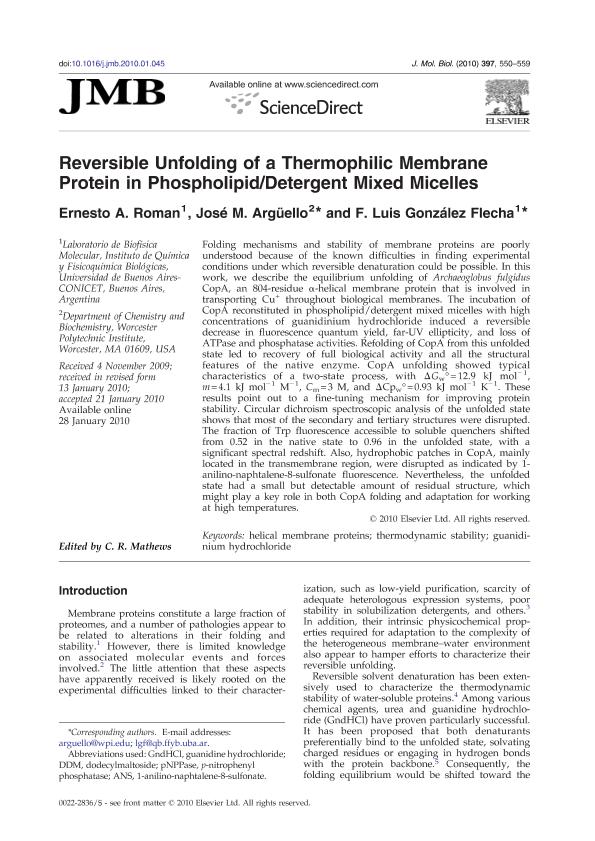Mostrar el registro sencillo del ítem
dc.contributor.author
Roman, Ernesto Andres

dc.contributor.author
Argüello, José M.
dc.contributor.author
Gonzalez Flecha, Francisco Luis

dc.date.available
2019-01-07T19:43:37Z
dc.date.issued
2010-03
dc.identifier.citation
Roman, Ernesto Andres; Argüello, José M.; Gonzalez Flecha, Francisco Luis; Reversible Unfolding of a Thermophilic Membrane Protein in Phospholipid/Detergent Mixed Micelles; Academic Press Ltd - Elsevier Science Ltd; Journal Of Molecular Biology; 397; 2; 3-2010; 550-559
dc.identifier.issn
0022-2836
dc.identifier.uri
http://hdl.handle.net/11336/67612
dc.description.abstract
Folding mechanisms and stability of membrane proteins are poorly understood because of the known difficulties in finding experimental conditions under which reversible denaturation could be possible. In this work, we describe the equilibrium unfolding of Archaeoglobus fulgidus CopA, an 804-residue α-helical membrane protein that is involved in transporting Cu+ throughout biological membranes. The incubation of CopA reconstituted in phospholipid/detergent mixed micelles with high concentrations of guanidinium hydrochloride induced a reversible decrease in fluorescence quantum yield, far-UV ellipticity, and loss of ATPase and phosphatase activities. Refolding of CopA from this unfolded state led to recovery of full biological activity and all the structural features of the native enzyme. CopA unfolding showed typical characteristics of a two-state process, with ΔGw° = 12.9 kJ mol- 1, m = 4.1 kJ mol- 1 M- 1, Cm = 3 M, and ΔCpw° = 0.93 kJ mol- 1 K- 1. These results point out to a fine-tuning mechanism for improving protein stability. Circular dichroism spectroscopic analysis of the unfolded state shows that most of the secondary and tertiary structures were disrupted. The fraction of Trp fluorescence accessible to soluble quenchers shifted from 0.52 in the native state to 0.96 in the unfolded state, with a significant spectral redshift. Also, hydrophobic patches in CopA, mainly located in the transmembrane region, were disrupted as indicated by 1-anilino-naphtalene-8-sulfonate fluorescence. Nevertheless, the unfolded state had a small but detectable amount of residual structure, which might play a key role in both CopA folding and adaptation for working at high temperatures.
dc.format
application/pdf
dc.language.iso
eng
dc.publisher
Academic Press Ltd - Elsevier Science Ltd

dc.rights
info:eu-repo/semantics/openAccess
dc.rights.uri
https://creativecommons.org/licenses/by-nc-sa/2.5/ar/
dc.subject
Guanidinium Hydrochloride
dc.subject
Helical Membrane Proteins
dc.subject
Thermodynamic Stability
dc.subject.classification
Otras Ciencias Biológicas

dc.subject.classification
Ciencias Biológicas

dc.subject.classification
CIENCIAS NATURALES Y EXACTAS

dc.title
Reversible Unfolding of a Thermophilic Membrane Protein in Phospholipid/Detergent Mixed Micelles
dc.type
info:eu-repo/semantics/article
dc.type
info:ar-repo/semantics/artículo
dc.type
info:eu-repo/semantics/publishedVersion
dc.date.updated
2019-01-07T13:56:05Z
dc.journal.volume
397
dc.journal.number
2
dc.journal.pagination
550-559
dc.journal.pais
Estados Unidos

dc.description.fil
Fil: Roman, Ernesto Andres. Consejo Nacional de Investigaciones Científicas y Técnicas. Oficina de Coordinación Administrativa Houssay. Instituto de Química y Físico-Química Biológicas "Prof. Alejandro C. Paladini". Universidad de Buenos Aires. Facultad de Farmacia y Bioquímica. Instituto de Química y Físico-Química Biológicas; Argentina
dc.description.fil
Fil: Argüello, José M.. Worcester Polytechnic Institute; Estados Unidos
dc.description.fil
Fil: Gonzalez Flecha, Francisco Luis. Consejo Nacional de Investigaciones Científicas y Técnicas. Oficina de Coordinación Administrativa Houssay. Instituto de Química y Físico-Química Biológicas "Prof. Alejandro C. Paladini". Universidad de Buenos Aires. Facultad de Farmacia y Bioquímica. Instituto de Química y Físico-Química Biológicas; Argentina
dc.journal.title
Journal Of Molecular Biology

dc.relation.alternativeid
info:eu-repo/semantics/altIdentifier/url/https://www.sciencedirect.com/science/article/pii/S0022283610000914
dc.relation.alternativeid
info:eu-repo/semantics/altIdentifier/doi/https://doi.org/10.1016/j.jmb.2010.01.045
Archivos asociados
